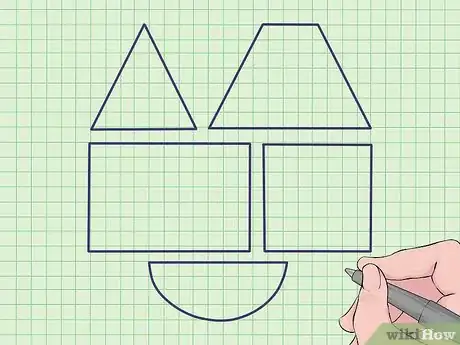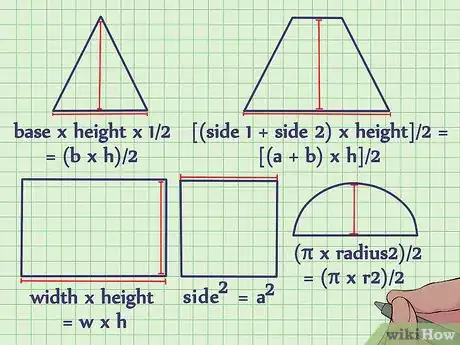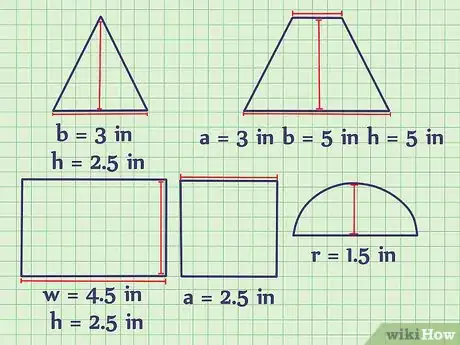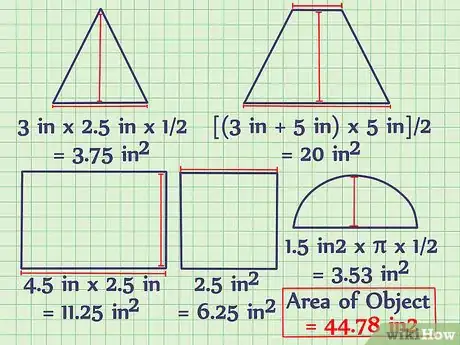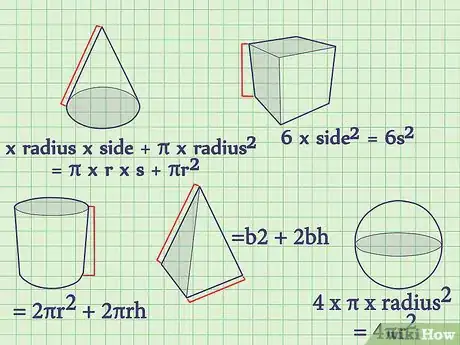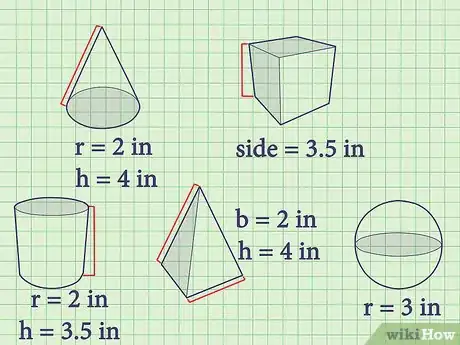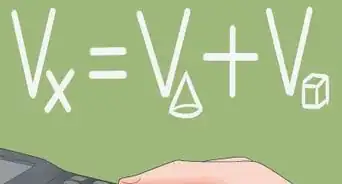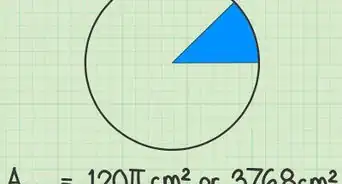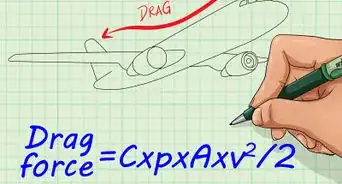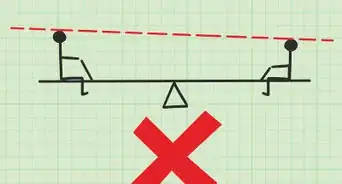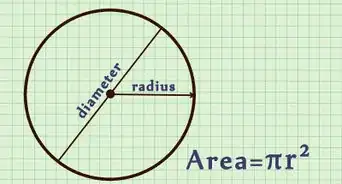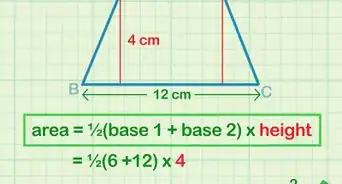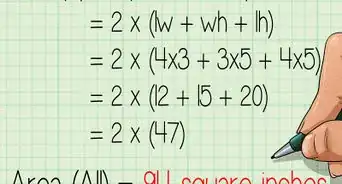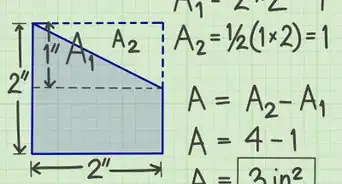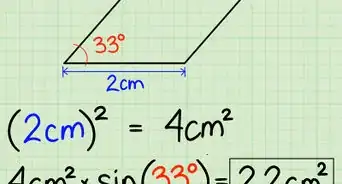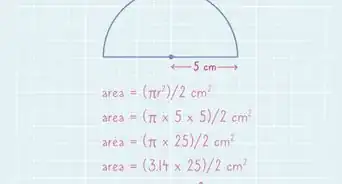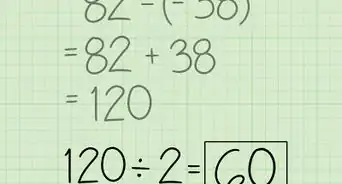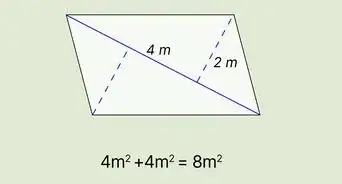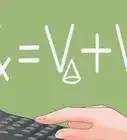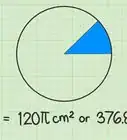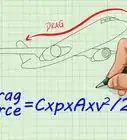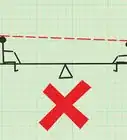This article was co-authored by David Jia. David Jia is an Academic Tutor and the Founder of LA Math Tutoring, a private tutoring company based in Los Angeles, California. With over 10 years of teaching experience, David works with students of all ages and grades in various subjects, as well as college admissions counseling and test preparation for the SAT, ACT, ISEE, and more. After attaining a perfect 800 math score and a 690 English score on the SAT, David was awarded the Dickinson Scholarship from the University of Miami, where he graduated with a Bachelor’s degree in Business Administration. Additionally, David has worked as an instructor for online videos for textbook companies such as Larson Texts, Big Ideas Learning, and Big Ideas Math.
This article has been viewed 435,726 times.
Finding the area of an object is easy as long as you understand the technique and formulas involved. If you have the right knowledge, you can find the area and surface area of any given object. See Step 1 below to get started.
Steps
Calculating the Area of Planar Objects
-
1Identify the shapes embedded in an object. If you're not working with a simple easily-identifiable shape, like a circle or a trapezoid, then you may be working with a shape that is made up of several other shapes. You have to recognize what those are so you can break the larger object down into a series of smaller objects.[1]
- In this case, this object is composed of the following shapes: a triangle, a trapezoid, a rectangle, a square, and a semi-circle (half of a circle).
-
2Write down the formulas for finding the area of each of these shapes. These formulas will allow you to use the given measurements of each shape to find their areas. Here are the formulas for finding the area of each shape:[2]
- Area of a Square = side2 = a2
- Area of a Rectangle = width x height = w x h
- Area of a Trapezoid = [(side 1 + side 2) x height]/2 = [(a + b) x h]/2
- Area of a Triangle = base x height x 1/2 = (b x h)/2
- Area of a Semi-Circle = (π x radius2)/2 = (π x r2)/2
Advertisement -
3Write down the dimensions of each shape. Once you write down the formulas, write down the dimensions of each shape so you can plug them in. Here are the dimensions of each shape:
- Square: a = 2.5 in
- Rectangle = w = 4.5 in, h = 2.5 in
- Trapezoid = a = 3 in, b = 5 in, h = 5 in
- Triangle = b = 3 in, h = 2.5 in
- Semi-Circle = r = 1.5 in
-
4Use the formulas and dimensions to find the area of each object and add them up. Finding the area of each shape will lead you to find the area of each part of the shape; once you've found the area of each shape using the formula and measurements you were given, all you have to do is add up each area to find the area of the entire object. When calculating area, you have to remember to state the area in square units. The area of the entire object is 44.78 in2. Here's how you get it:[3]
- Find the area of each shape:
- Area of Square = 2.5 in2 = 6.25 in2
- Rectangle = 4.5 in x 2.5 in = 11.25 in2
- Trapezoid = [(3 in + 5 in) x 5 in]/2 = 20 in2
- Triangle = 3 in x 2.5 in x 1/2 = 3.75 in2
- Semi-Circle = 1.5 in2 x π x 1/2 = 3.53 in2
- Add the areas of each shape together:
- Area of Object = Area of Square + Area of Rectangle + Area of Trapezoid + Area of Semi-Circle
- Area of Object = 6.25 in2 + 11.25 in2 + 20 in2 + 3.75 in2 + 3.53 in2
- Area of Object = 44.78 in2
- Find the area of each shape:
Calculating the Surface Area of 3-D Objects
-
1Write down the formulas for finding the surface area of each shape. The surface area is the total area of an object's faces and curved surfaces. Every three dimensional object has a surface area; the volume is the amount of space taken up by the object. Here are the formulas for finding the surface area of a variety of objects:[4]
- Surface area of a square = 6 x side2 = 6s2
- Surface area of a cone = π x radius x side + π x radius2 = π x r x s + πr2
- Surface area of a sphere = 4 x π x radius2 = 4πr2
- Surface area of a cylinder = 2 x π x radius2 + 2 x π x radius x height = 2πr2 + 2πrh
- Surface area of a square-based pyramid = side of base2 + 2 x side of base x h = b2 + 2bh
-
2Write down the dimensions of each shape. Here they are:
- Cube = side = 3.5 in
- Cone = r = 2 in, h = 4 in
- Sphere = r = 3 in
- Cylinder = r = 2 in, h = 3.5 in
- Square-Based Pyramid = b = 2 in, h = 4 in
-
3Calculate the surface area of each shape. Now, all you have to do is plug the dimensions of each shape into the formula for finding the surface area of each shape and you're all done. Here's how you do it:[5]
- Surface area of the cube = 6 x 3.52 = 73.5 in2
- Surface area of the cone = π(2 x 4) + π x 22 = 37.7 in2
- Surface are of the sphere = 4 x π x 32 = 113.09 in2
- Surface are of the cylinder = 2π x 22 + 2π(2 x 3.5) = 69.1 in2
- Surface area of the square-based pyramid = 22 + 2(2 x 4) = 20 in2
Community Q&A
-
QuestionHow can I calculate the volume of a 3D shape?
 Community AnswerAll shapes are different, but here is how to calculate cubes specifically: First you would need to have all of the dimensions (length, width, and height) of the cube. Then, you would multiply the dimensions and the formula would be l*w*h or length times width times height in word form.
Community AnswerAll shapes are different, but here is how to calculate cubes specifically: First you would need to have all of the dimensions (length, width, and height) of the cube. Then, you would multiply the dimensions and the formula would be l*w*h or length times width times height in word form. -
QuestionHow do I calculate area given length and width?
 Community AnswerIn the case of a square, rectangle, or parallelogram, multiply length by width.
Community AnswerIn the case of a square, rectangle, or parallelogram, multiply length by width. -
QuestionIf a line is 100 meters in length, is the area constant for any object it forms; triangle, square, circle?
 DonaganTop AnswererNo, the area varies by shape. For all shapes of a given perimeter, the circle has the largest area.
DonaganTop AnswererNo, the area varies by shape. For all shapes of a given perimeter, the circle has the largest area.
Warnings
- Don't confuse between area and surface area both are the same but are used differently. Area is used in case of planar objects and surface area is used in case of 3D objects.⧼thumbs_response⧽
References
- ↑ https://www.fao.org/3/R7021E/r7021e06.htm
- ↑ https://www.mathsisfun.com/area.html
- ↑ https://www.khanacademy.org/math/geometry-home/geometry-area-perimeter/geometry-perimeter/v/perimeter-and-area-basics
- ↑ https://www.cimt.org.uk/projects/mepres/book9/bk9i9/bk9_9i4.html
- ↑ https://sciencenotes.org/surface-area-formulas-volume-formulas/
About This Article
To calculate the area of a planar object, you’ll need the formula for the object depending on the shape of the object. For example, to get the area of a rectangle, you multiply the width by the height, and to calculate the area of a triangle, you multiply the base by the height and divide by half. If you have an irregular shape, you may need to break it up into smaller shapes with a known formula for the area. If you want to learn how to find the surface area of a 3-D object, keep reading the article!
